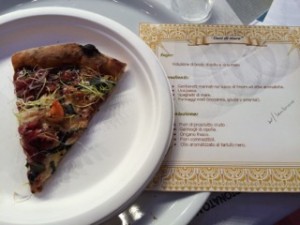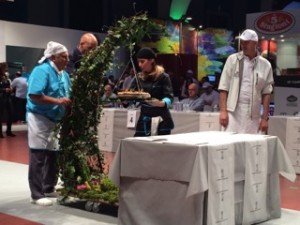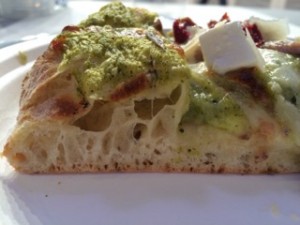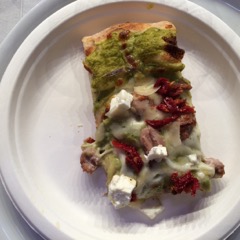Pizza in Parma: Judging at The World Cup of Pizza, Part One
As much as I love them, pizza competitions are super weird. You only get one shot to make the greatest pizza of your life, the one that’s going to win you the pride and admiration of all your friends and colleagues, but you have to do it in a strange place with an unfamiliar oven and dough you made in the hotel bathroom sink. These factors plague my brain while I’m sitting behind the judge’s table scrutinizing slices from some of the best pizza makers on the planet. I’ve been judging American pizza competitions since 2007 and recently returned from my first experience judging an Italian event – the Pizza World Championship in Parma – and my head is still reeling.
Judging pizza is a bit out of character for me because I don’t openly critique food, I never offer unsolicited advice, and I most certainly don’t report my every disappointment to online rating sites. But when someone offers me a seat on the arbitration panel at a big event in Italy, I can’t turn it down. I’m totally down to judge pizza made by someone for the sole purpose of being judged.
The Pizza World Championship competition is split into four main styles: Classica (anything goes), STG (basic pizza Napoletana), pizza in teglia (pan pizza), and pizza in pala (long pizzas baked directly on the oven floor). Rather than judge a set of pizzas from a single style at a time, judges were faced with a barrage of entries from all categories. Each competitor presented his or her pizza to the head judge, who then sent it to one of the six judging panels. If one of us felt that we could not accurately assess a pizza because of our relationship with the pizzaiolo, the head judge would send it to another table.
Some competitors presented their pies with lavish garnish and ornamentation. Apparently there used to be a separate prize for presentation, but this year it was all about the pizza. Even so, lots of pizzas were rolled out on displays that looked more like parade floats than anything. It was really impressive, but didn’t impact the food score at all.
We awarded points in two sections: bake and overall taste. In each category, we gave a score of 30-100. Upon presentation, whichever judge was sitting at the middle of the table had the implicit responsibility to lift and inspect the underside of each pizza, showing it to the judges on both sides of the table before sending it off to be cut. We looked for a consistent stretch and an even bake, docking points for excessive burn or raw spots. Once we had our slices on the table, we further investigated the bake by analyzing the crumb. This is where understanding each pizza style was extremely important because there should be different sets of expectations for pizza in pala, STG, and pizza in teglio. Density isn’t always bad; it just needs to be presented in the appropriate context.
After scoring the bake, we’d move on to the pizza’s overall flavor. After my tenth slice, I started to notice some major ingredient trends. At first I thought there must have been a sale on asparagus at the local grocery store, but then I realized it’s spring and seasonal ingredients were clearly a good way to deliver deep flavor. I noticed tons of salmon (usually smoked) zucchini flowers, and walnuts. We were in Parma, so I shouldn’t have been at all surprised to see prosciutto on at least 65% of the pizzas I evaluated. Coming from New York, these pizzas all seemed intensely 3-D. I guess that’s what happens when you make a pizza that aims at visual appeal as much as flavor profile, whereas my more familiar New York slices are completely utilitarian.

Some pizzas makers submit a recipe card to the judges, especially if they don’t speak fluent Italian or English.
About half the pizzas that landed on my table were paired with wine or beer. The trick here was to rate the pizza first, then taste the beverage. For the most part, libations didn’t enhance pizzas significantly. I was surprised by how many of the pizzaioli paired their pies with Prosecco. It makes more sense when I think about how few of the pizzas had a tomato component. It was actually quite refreshing to get a rare pizza Margherita or marinara.
The difference between a winning pie and one that gets sent to the trash can be as simple as a dirty oven or a poorly timed rotation. Competitions like this one are a true test of great pizzaioli, who are rewarded for performing at such high levels even in the face of uncertainty. I’m always happy to add my two cents at these events and crown pizza makers who demonstrate a deep understanding of the variables at play and are able to not only overcome them, but also to use them to their advantage.
Coming Soon: Part Two — The Winners!
Recent Articles by Scott Wiener
- Pizza Box of the Week #23: When Brooklyn is in Canada
- Pizza Box of the Week # 20: A Box Within a Box Within a Box
- Pizza Box of the Week #19: Is it a Book or is it a Box?
- Pizza Box of the Week #16: The Moped Motorino Box from France
- Pizza Box of the Week #15: The Ventit Box — and How to Re-Heat a Pizza
- Pizza Box of the Week with Scott Wiener, #14: Famous O’s, Karachi, Pakistan













